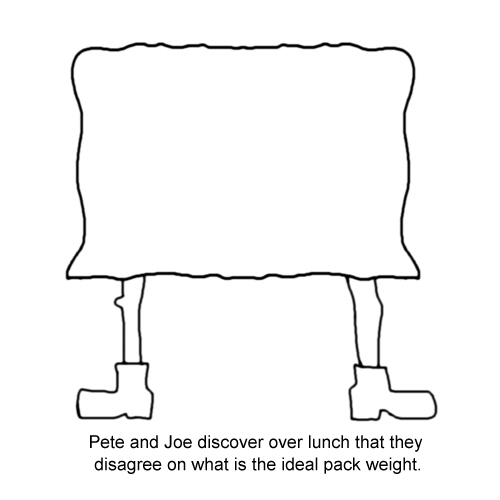Adventure in a bag.
I admire the British. Robust, adventurous, stout-hearted people. Able to live successfully in a disadvantageous climate due partly to their character (stiff upper lip, never say die) and their clever use of woolens and abundant body hair (especially some of the women).
You could say that Britain's "temperate maritime climate" is, well, tentatively temperate. With an average yearly low at 1°C (34°F), that doesn't seem bad. The average high of 21°C (70°F) doesn't seem bad either. But add 800 days a year of lead-gray skies and blowing mist, and you have a problem.
This is hypothermia country.
It is also a country of inveterate walkers.
The British (Welsh, Scots, English, Leprechauns, and so on) have an almost unnerving desire to abandon their cozy spots by the hearth and go tromping around here and there. This may be why they once ruled every part of the world worth stealing.
If you've seen pictures of the British Isles you may have noticed that the countryside is at least 99% grassland, and something like 27% rocky outcrops, with small groves of stunted shrubs standing in for what used to be endless medieval forests.
All now, all of it, incessantly whipped by gale-force winds carrying countless stinging droplets of icewater.
Ben Nevis, the highest point in the British Isles, is typical. You can look it up. A gigantic heartless lump of barren rock. Yearly precipitation: 4000mm (161 inches). Constant howling frigid wind.
And yet people persist in tramping all over it.
Still, with all their tweeds and mittens and furry legs, the British require a bit more protection from the elements, especially when sitting down for lunch, on bare ground, in a gale, in blind fog, on a mountain which has no inherent scenic qualities or redeeming virtues whatsoever.
So, what would you do? I mean, if you had to be there and couldn't get away.
Well, the British decided to put bags over their heads.
This seemed like such a nifty idea that they kept doing on it.
The bags got bigger and bigger until a person's whole body fit inside, and then someone thought "Hey. What about my friends?" And so the bothy bag was invented. Some of these are now large enough to seat 12. Think of it.
For a measure of this invention's romance, consider the bothy bag's inspiration: "I lived in a broken down long-deserted shepherd's hut, known as a bothy, out on a windy Scottish mountainside, without electricity." (From a work titled "To The Hilt", which may have been about suicide.)
The idea is that you and your friends, all freezing, damp, and shivering, unfold this big fabric bag and pull it over yourselves. Then you sit inside it, all facing each other, and breathe each other's breath and get wetter from condensation, and possibly stinkier, and then you break out your cold damp lunch and eat it, listening to everyone else chew, swallow, and wheeze.
There is no frame to a bothy bag. There are no stakes or guy lines.
There may be vents, and a plastic window or two so you can see what misery surrounds you, but the whole thing is supported by the bodies of the occupants, who stay inside the bothy bag until realizing that quick death out in the open is preferable to a suffocating death by re-breathing re-breathed air heavy with wool-stink. Not to mention being solidly wedged in foot to crotch and nose to eyebrow with everyone else.
So there you have it. A nearly perfect solution to dealing with life outdoors in a tricky climate.
The other solution, of course (which the British can no longer afford), is moving somewhere decent.
More:
Bothy bags
Bothy Bag
Ben Donich in a Bothy Bag (good pics)
At MoonTrail: Terra Nova Superlite Bothy 2
At Brooks-Range: UltraLite Alpini Shelter 200





